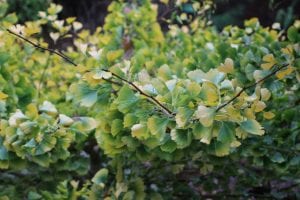
The Chinese Medicinal Herb Garden has been developed as a collaborative project between the University of Bristol Botanic Garden and the Register of Chinese Herbal Medicine. Begun in 2000 it has developed consistently over the past eleven years. The garden at The Holmes has been designed in line with a traditional Chinese garden found in the ancient city of Suzhou, near Shanghi. On entering the garden through a traditional ‘moongate’, you will see to your right the recently constructed ‘laing’ (a pergola clothed in climbing plants with defined views out to landscape beyond the garden) and a pavilion. The garden is unique in Europe and grows 180 species, the largest collection of traditional Chinese medicinal herbs in the UK. It aims to provide a comprehensive collection of plants used in traditional Chinese herbal medicine. These are employed in the teaching of students of herbal medicine through the Register of Chinese Herbal Medicine and for research by the herbal medicine profession into the cultivation and chemistry of the plants. The garden is affiliated with Nanjing Botanic Garden in China which has provided information on plant cultivation and helped obtain new plants. The garden was formally opened on 8 July 2010 by Minister Attaché for Science and Technology, Chen Fu Tao, from the Chinese Embassy, London.
The garden is divided into several distinct areas which reflect current interests in Chinese herbal medicine. The most important is the ‘use class teaching garden’ which displays plants according to their use categories in traditional Chinese herbal medicine. Fourteen use categories are displayed around a central paved area large enough for students to gather and study the plants. The use categories are arranged in two halves (Yin and Yang) one dedicated to plants for reducing ‘excesses’ in the body, and the second to plants for correcting ‘deficiencies’ in the body.

The display is home to familiar plants like black bamboo (Phyllostachys nigra), ginkgo (Ginkgo biloba) and the loquat (Eriobotrya japonica) and many unfamiliar plants such as Sichuan pepper (Zanthoxylum bungeanum) and Chinese paper plant (Tetrapanax papyrifera). Through our partner garden, Nanjing Botanic Garden, the University of Bristol Botanic Garden has been able to introduce species new to cultivation in the United Kingdom such as the cinnabar root (Salvia miltiorrhiza), and also a comprehensive collection of sacred lotus (Nelumbo nucifera) cultivars.
The conservation bed displays plants that are under threat in their native China through habitat loss and non-sustainable collecting. This display has recently been planted with Magnolia officinalis, Eucommia ulmoides and geographic forms of Cornus officinalis, Further development of the display is planned and will include a separate section for endangered Himalayan herbs.
A peony display is being developed that will include peony cultivars derived from Paeonia suffruticosa, P. veitchii, P. obovata and P. lactiflora. These species are important Chinese herbs and will be grown to illustrate flower and chemical comparisons and as decorative plants in-keeping with the design principles of traditional Suzhou gardens.
The fern display is being created to promote the use of this group of plants in medicine. The collection currently includes the familiar shuttle-cock fern (Matteuccia struthiopteris), and Dryopteris crassirhizoma, and in the glasshouses the endangered golden chicken fern or woolly fern (Cibotium baromtez). The existing backdrop of evergreen yews provides shade and shelter for these woodland loving plants.
In the future a research bed is being planned that will demonstrate plants currently being used in research. Comparative studies between Chinese and European species of the same genus are planned and will be displayed. For more information on current research please see the Register of Chinese Herbal Medicine.
Close links between the Chinese medicinal plants collection and Ayurvedic (an ancient Indian philosophy of health and wellbeing) medicine enable the collection to be used to support the awareness of Ayurvedic medicine. The tropical zone in the glasshouses provides an environment for the cultivation of many Ayurvedic medicinal plants such as: vanilla (Vanilla planifolia),ginger (Zingiber officinale) and turmeric (Curcuma longa).
Click here for a full list of plants in this collection.

